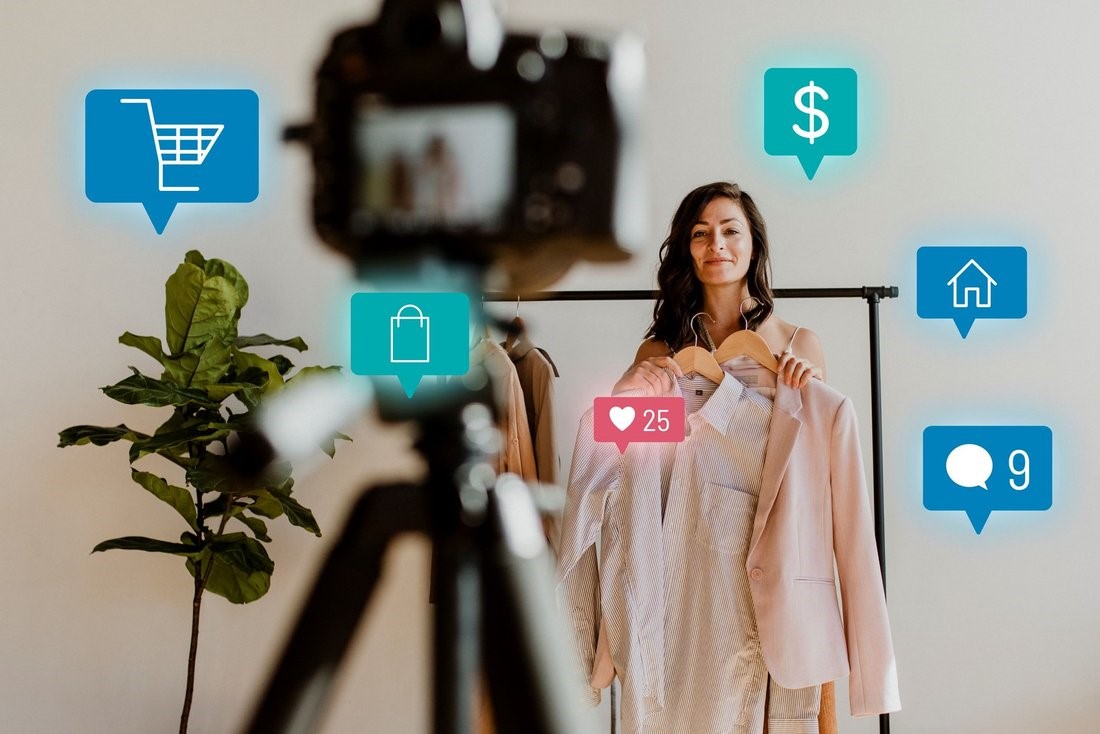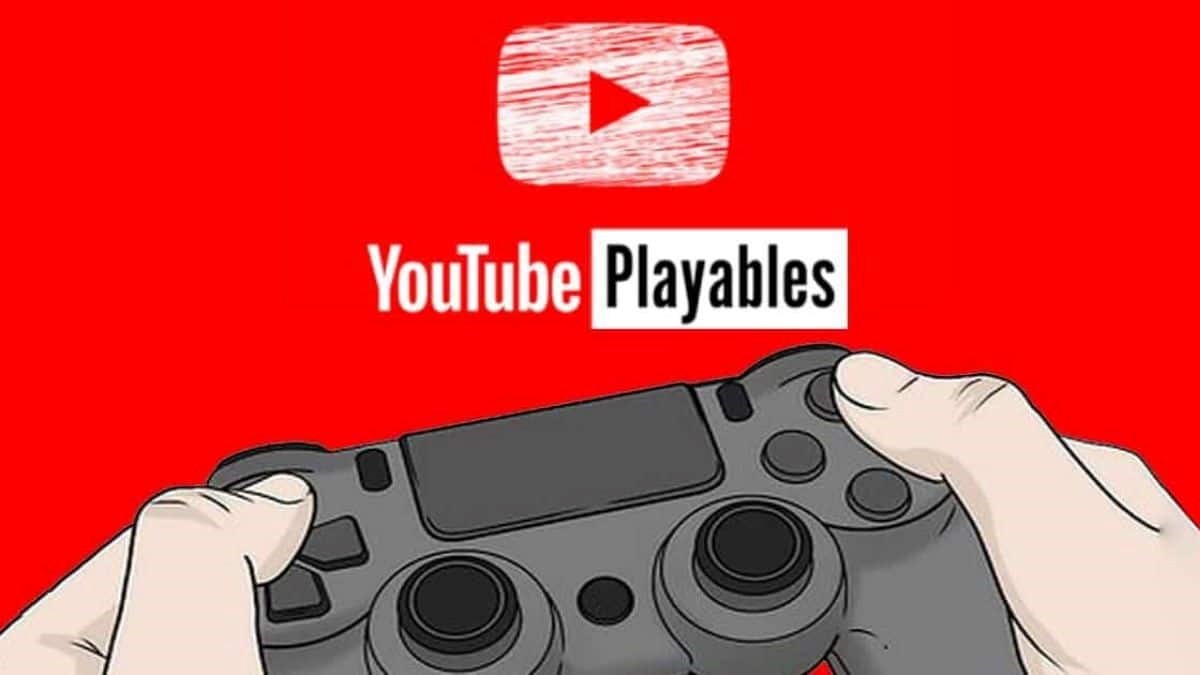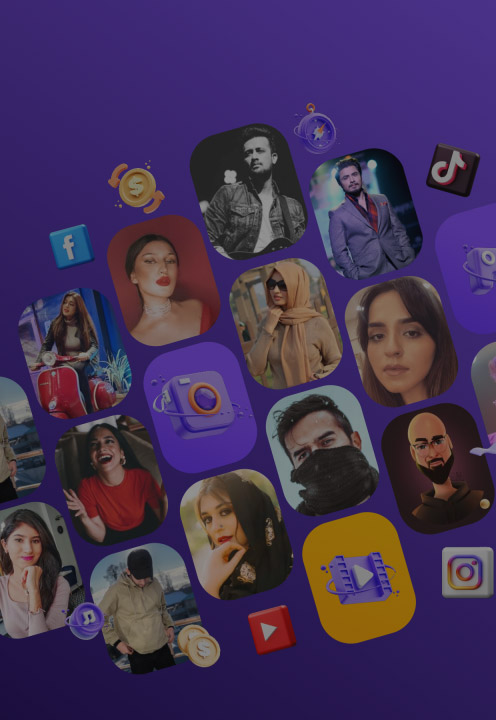Industry snapshot: content creators at the heart of storytelling
Walee’s Rizk Haddad explores the shift away from vanity metrics to authentic, ROI-driven storytelling in the content creator economy.In this industry snapshot, Rizk Haddad, Head of Monetization & Operation – MENA at Walee, explores the shift in the role of content creators in influencer marketing. He also shares how the industry is moving away from vanity metrics and moving towards authentic, ROI-driven storytelling that builds lasting brand connections.
How important is it to move beyond followers and focus on local content creators who reflect brand values?
In today’s landscape, brands must prioritise genuine connection over vanity metrics. At Walee, we champion storytelling that goes beyond manufactured narratives, placing values-aligned, local content creators at the heart of brand storytelling. Real brand impact now lies in trust-building actions and emotionally compelling, human-driven narratives.
How can influencer marketing balance creativity with measurable ROI?
Walee’s influencer solutions bridge storytelling with measurable results. Our tech and data stack aligns with media and business KPIs, ensuring campaigns deliver trackable ROI. Tools like UTM links, pixels, and promo codes allow end-to-end funnel tracking, while predictive performance modelling empowers ongoing optimisation.
Is the focus shifting from whom the influencers or creators are to how content is shared?
The industry is evolving – from chasing follower counts to crafting content that resonates. Today, it’s about strategic content delivery: the right creators, platforms, formats, and audiences. Walee’s approach blends cultural resonance with data insights, ensuring each piece of content drives both emotional and business outcomes.
Are influencer campaigns optimised for full-funnel impact?
Too many campaigns stop at awareness. At Walee, we integrate influencer strategies across the entire funnel – from discovery to conversion. Through data-led targeting and strategic creator alignment, we help brands turn influencers into conversion drivers, not just storytellers.
Are AI influencers a passing trend or the future?
AI influencers offer scalability and control, but they still lack true human relatability. Walee’s upcoming launch of an authentic Arabic AI persona merges cultural relevance with innovation, offering brands a new way to connect – without losing the power of emotion-driven marketing.
Are influencers or content creators now defined by impact rather than celebrity?
The definition of ‘influencer’ is expanding. Today, trust is built through expertise and relatability – whether in sports, science, arts or aviation. Walee partners with creators across diverse sectors to deliver deeper, value-led engagement that resonates with real audiences.
What’s the biggest influencer marketing challenge for 2025?
Trust and relevance. With audiences growing more discerning, the focus must shift to authenticity, platform-native content and micro-engagement. Walee’s data-first approach ensures content is not just seen – but trusted, felt, and acted upon.
Rise of Creator Brands: Surpassing Traditional Brands
The rise of creator brands has helped Social media influencers surpass traditional brands and shake up established systems with their own brands. Influencers interact with their communities regularly, and these communities are extremely loyal. This loyalty is unmatched and gives influencers remarkable selling influence. This strong devotion allows them to build brands as big as their followers.
The Influence of Trust
Traditional advertising methods have seen a decline in effectiveness, with 47% of customers resorting to Adblock technology. In this climate, the power of influencers shines through. Data from MuseFind reveals that a staggering 92% of consumers trust influencers more than traditional advertising or celebrity endorsements. This high level of trust is a testament to the genuine connections that influencers build with their audiences.
MrBeast Burger: An Iconic Example: Jimmy Donaldson, known by his 275 million followers as MrBeast, is a prime example of the influence and reach that a creator-led brand can achieve. A philanthropic YouTuber, Jimmy has not only amassed a massive following but has also leveraged his online presence to create MrBeast Burger, a brand that bridges the gap between the digital and physical worlds. What started as a virtual concept in 2020 quickly grew into a global sensation.
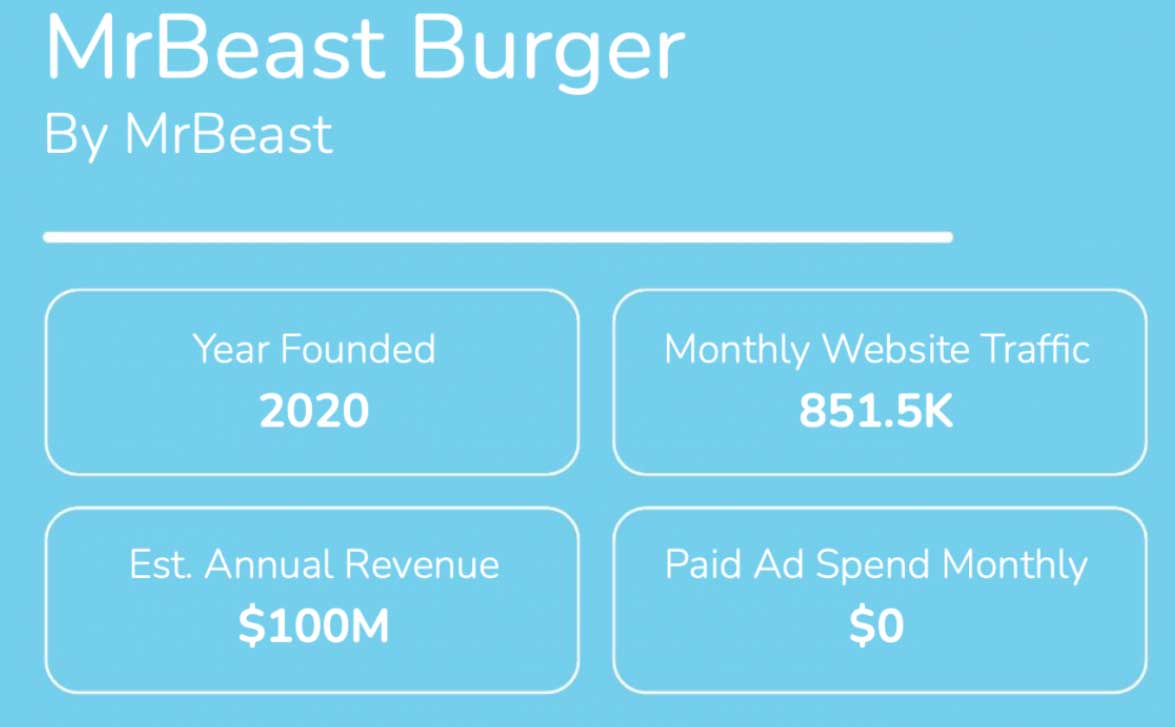
With online locations sprouting across the globe. The brand’s expansion from the digital realm to brick-and-mortar stores, including a world-record-breaking launch in New Jersey, showcases the limitless potential of creator-led brands. It highlights how influencers can translate their digital influence into real-world impact.
In our local context, we have numerous inspiring instances of homegrown influencers who have established their brands. Irfan Junejo, for instance, introduced Scnzcrew, while Laraib Rahim is known for her brand Organic Brown. Additionally, Syeda Urooj Fatima has introduced Serendipitybyrooj, and Waliya Najib has garnered attention with her brand PrelovedbyWaliya. The list continues endlessly with such smart examples.
The rise of these brands challenges the traditional notion of starting with a grand vision. These brands are less focused on a big purpose and more centered around the personality of the creator. They prioritize authenticity, connection, and interactivity with their audience. Video content is the primary communication medium, emphasizing the importance of direct engagement.
Creator brands benefit from their community of loyal followers. These communities provide valuable feedback and secure the product-market fit. As seen in the above cases, an influencer’s understanding of their audience’s preferences and interests drives content creation and brand expansion.
Rise of Creator brand along with Challenges and Rewards
While creator-led brands offer significant advantages, they also come with unique challenges. The creator’s personal brand is closely tied to the success of the brand, making individual decisions critical. Scaling can also be challenging as multiple brands and products enter the picture. However, solid diversification strategies and collaboration with secondary characters from the creator’s universe can alleviate these challenges.
Creator-led brands are rewriting the rules of brand building. They thrive on trust, authenticity, and direct engagement with their communities. The success of MrBeast Burger and other creator-led brands demonstrates the power of influencers to transcend the digital realm and make a significant impact in the real world. As we move forward, it is essential to consider how we can re-strategize our approach to establish and nurture these vital connections with our audience.
YouTube playing games
In 2023, there’s some exciting news for YouTube enthusiasts! Google made headlines at the start of the year when it decided to discontinue its cloud gaming project, Google Stadia. This decision was due to its struggle to gain substantial traction. It faced fierce competition from industry giants like Microsoft’s Xbox Cloud Gaming and Nvidia GeForce Now. According to data shared by the U.K.’s Competition and Markets Authority (CMA), Stadia held a meagre estimated 0-5% share of the cloud gaming market in 2022. In contrast, Nvidia GeForce boasted a considerably larger 20-30% share.
But here’s the exciting twist. Google is reentering the gaming arena, introducing an intriguing concept known as “Playables,” this time via YouTube.
This feature enables users to seamlessly play games on both the desktop website and mobile devices. The Playables section currently restricts access to a select number of users. It signifies an exciting development in the ever-evolving landscape of online entertainment.
In the YouTube Playables, you can find games like Stack Bounce. This game lets you take charge of a 3D ball that bounces on top of rings. Your mission? To click at just the right moment to smash through obstacles. If this game sounds familiar, it’s because Google already includes it in their collection of mini-games known as “GameSnacks.”
To see if you’re one of the chosen ones in this gaming experiment, keep an eye out for the “Playables” section on your YouTube homepage.
It’s nestled among the typical content. This expansion adds yet another layer of entertainment to the YouTube brand. It joins the ranks of short-form videos, movies, video game streams, music, TV services, podcasts, and more.
However, YouTube is not the only streaming platform testing the gaming waters.
Netflix and TikTok entered the gaming industry, offering games to selected audiences. TikTok has even experimented with enabling streamers to play alongside their viewers and has hosted live trivia contests with cash prizes, further blurring the lines between social media and gaming.
The introduction of games into the YouTube experience is transforming user engagement. It holds the potential to create a new avenue for interaction.
In a world where entertainment options continue to expand, YouTube’s foray into gaming signifies its commitment to providing diverse content. It aims to engage its ever-growing audience effectively. As this experimental phase unfolds, it will be fascinating to observe. We’ll witness how this new dimension of YouTube transforms the online entertainment landscape.
EMV: The Key to Driving Sales and Growth
The importance of earned media value (EMV) in today’s marketing landscape cannot be overstated. EMV is a measure of the value of unpaid media coverage, such as mentions in social media, press releases, and blog posts. It can be a powerful tool for brands to measure the impact of their marketing efforts and to track their progress over time.
A powerful way to increase EMV is through creator media/influencer marketing. You can reach a large audience and generate a lot of engagement when a trusted creator or influencer shares positive content about your brand. This can lead to increased brand awareness, website traffic, and sales.
For example, in 2021 Lux partnered with Pakistani actress Mahira Khan to promote its new range of skincare products. Khan shared a series of videos on her social media channels talking about the products and how they had helped her to improve her skin. The campaign was a huge success, generating over 1 million views on social media and driving a significant increase in sales of the products.
Another example of how influencer marketing can boost EMV is the case of Glossier. Glossier is a beauty brand that has built a strong following on social media (2.8M followers). The brand works with a network of influencers to promote its products, and these influencers often create highly engaging content that resonates with Glossier’s target audience. As a result, Glossier has been able to achieve high levels of EMV, which has helped to drive sales and growth.
The food delivery service Foodpanda has also partnered with a number of Pakistani influencers to promote its brand. For example, in 2022, it partnered with the YouTuber Faizan Sheikh to promote its new food delivery service. Sheikh created a series of videos on his YouTube channel talking about the service and how it could help people to order food from their favorite restaurants. The campaign was a success, generating over 1 million views on YouTube and driving a significant increase in orders.
In addition to increasing brand awareness and driving sales, EMV can also help to build trust and credibility with consumers. When consumers see positive content about a brand from trusted sources, they are more likely to be influenced by that content. This can lead to increased brand loyalty and repeat business.
In 2019, Nike partnered with Serena Williams to promote its new Air Max 720 sneaker. Williams shared a video on her social media channels wearing the sneaker, and the post generated over 1 million likes and 50,000 comments. This resulted in a significant increase in sales of the sneaker, and it also helped to boost Nike’s brand image.
A study by Nielsen found that 92% of consumers trust recommendations from people they know, while only 68% trust traditional advertising.
Overall, EMV is a valuable metric for brands to track. By measuring EMV, brands can get a better understanding of the impact of their marketing efforts and make informed decisions about how to allocate their resources. Additionally, EMV can help brands to build trust and credibility with consumers, which can lead to increased sales and growth.
Future Platforms for Influencer Marketing beyond Instagram
BEYOND INSTAGRAM: THE FUTURE PLATFORMS FOR INFLUENCER MARKETING
In Pakistan, marketers often confuse Influencer Marketing for Instagram alone. And yes, Instagram has made it very popular with various storytelling formats such as posts, stores and now the hugely popular reels. But today, let’s venture off the well-worn path and explore the dynamic social landscape in Pakistan. Let’s dive into treasures like Snapchat, TikTok, and SnackVideo, quietly reshaping influencer marketing in Pakistan, and globally.
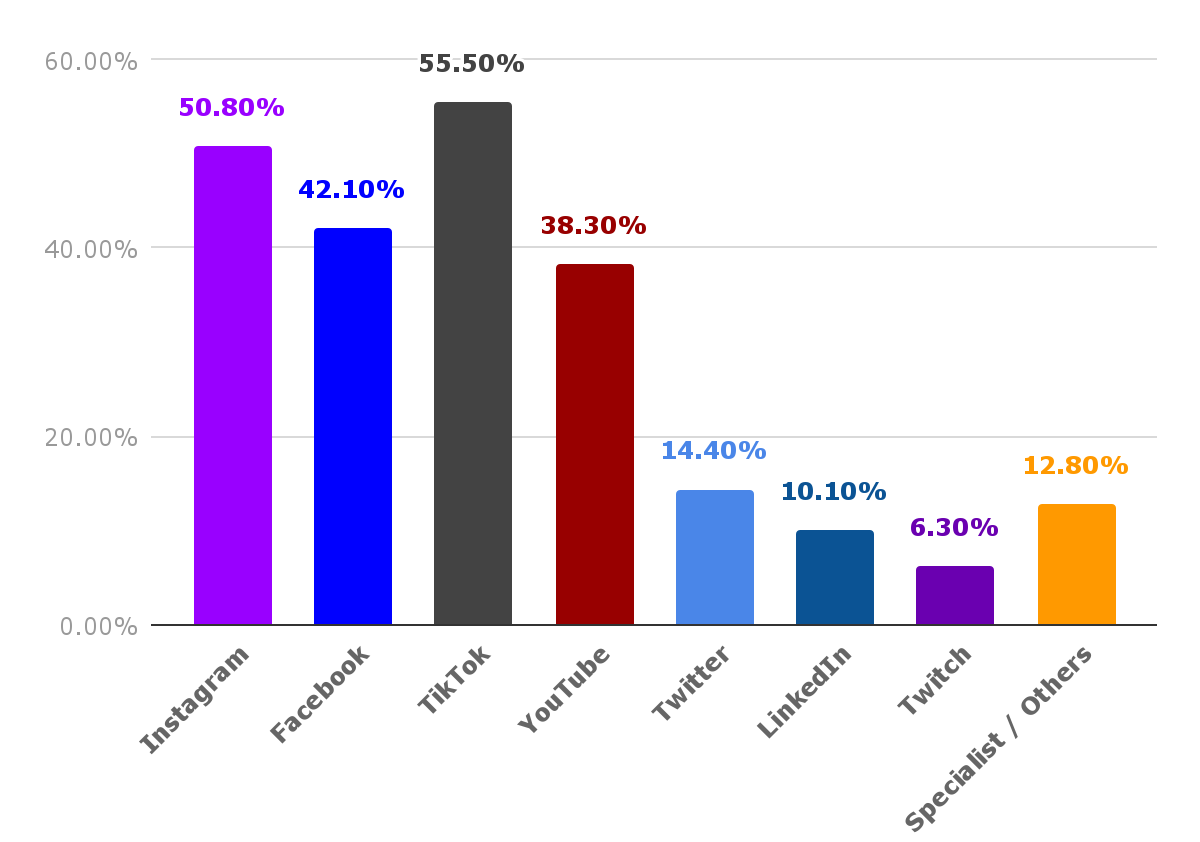
Tik Tok
👉TikTok, with a 55.50% share of influencer marketing campaigns, has taken the global influencer marketing landscape by storm, surpassing Instagram’s 50.80%. TikTok has also gained significant popularity among marketers, not just in Pakistan but worldwide. It boasts 40+ million users in Pakistan ahead of Instagram by far and yet less than 25% of the Influencer Campaigns include it in Pakistan. Tiktok influencers are better storytellers, have a much bigger reach and deliver amazing Cost per View. Brands can harness TikTok’s creative energy to build meaningful connections and drive growth.
Snapchat
👉 Snapchat, with a whopping 18.8 million users in Pakistan, is unique for its focus on privacy and fleeting content. This appeals to Pakistanis who cherish personal space. Brands can connect with this large and engaged audience, making Snapchat a vital part of influencer marketing strategies.
Snack Video
👉 SnackVideo, with its Snapchat-like appeal, is making waves with ~18 million millennials and Gen Z users. It’s a diverse hub for creators and businesses looking to engage the next generation.
Innovative brands like FoodPanda are already using these platforms for influential marketing campaigns. Meanwhile, giants like Telenor offer specialized data packages for Snapchat, SnackVideo, and TikTok, expanding their digital reach and reshaping marketing in the fast-paced digital age.
Businesses leveraging Snapchat, TikTok, and SnackVideo for their influencer marketing activities can take advantage of video-first content, high reach, and younger audience appeal. To wrap up, uncharted territories lead to the most exciting discoveries. Keep exploring, keep innovating, and keep an eye on these hidden gems as you navigate the Creator Media Space. Happy venturing.
7 Strategies to Amplify Influencer Marketing ROI
In recent years, influencer marketing has emerged as a powerful tool for brands looking to connect with their target audiences in an authentic and engaging manner. Unlike traditional expensive television commercials (TVCs), which can often be disruptive and face diminishing returns, influencer marketing offers a more subtle and effective way to resonate with audiences. By leveraging the right influencers and employing advanced tactics, brands can significantly amplify their return on investment (ROI) and create lasting connections with their customers.
1. Micro-Influencers: The Power of Niche Authenticity
While macro-influencers might have a larger following, micro-influencers (influencers with relatively smaller followings, typically between 10,000 to 50,000) have become a force to be reckoned with. These individuals often have highly engaged, niche audiences with whom they have developed genuine relationships. Using the right influencer insights tool, like the one WALEE has, can help you compare avg. engagement of micro vs. macro influencers, and their particular audience sets to see what works better for your brand.
2. AI-Driven Influencer Selection: Finding the Perfect Match
Selecting the right influencers is crucial to the success of any influencer marketing campaign. Advanced Artificial Intelligence (AI) tools can now help brands identify the best-fit influencers based on factors like audience demographics, interests, and past campaign performance. By analyzing vast amounts of data, AI enables brands to make data-driven decisions and partner with influencers who are more likely to resonate with their target audience.
3. Embrace Long-Term Partnerships: Building Trust Over Time
Rather than pursuing one-off influencer collaborations, consider forging long-term partnerships. Long-term associations create a sense of authenticity and trust between the influencer and the brand, which can significantly impact the effectiveness of the sponsored content. As the influencer continues to promote the brand over time, their audience is more likely to view the association as genuine, leading to increased brand loyalty. In recent times, many brands are now working on building such partnerships for e.g. Foodpanda (easy deliveries for groceries and food)and HBL(discounts on restaurants)- the brands collaborated with multiple influencers(Muzammil Hassan, Human Raza, Waliya Najib etc.) plugging in the 2 services into their story & post content over the course of several months, making it look genuine.
4. Storytelling through Sponsored Content: Captivating Audiences
Gone are the days of overtly promotional sponsored content. To connect with audiences, influencers should focus on storytelling that integrates the brand seamlessly into their narrative. Story-driven content enables influencers to create a meaningful and emotional connection with their followers, resulting in higher engagement and improved ROI. A Lahore/London based influencer named Baekartoot recently did a similar piece, in which she connected with her audience over how hard it is for kids living abroad, to send back remittances, and she struggled with this too, then plugging in an application which can now help you do so operational in many countries.
5. Leverage User-Generated Content (UGC): Authenticity at Its Best
User-generated content (UGC) has gained immense popularity due to its authentic and relatable nature. Encouraging influencers and their followers to create UGC around your brand or products not only expands your reach but also bolsters trust among potential customers. Reposting UGC also reinforces the influencer-brand connection and shows appreciation for their support. Influencers now do stories on ‘post your moment’ and ‘share your photos’ in relevance to a topic to leverage UGC for a sponsored plug.
6. Data-Driven Campaign Optimization: Maximising Impact
The beauty of influencer marketing lies in its measurability. While traditionally brands rely on PR agencies sending in post-campaign reports that may be plagered or exaggerated, brands can now instead resolve to look at live insights for their campaigns, track key performance metrics such as engagement rates, click-through rates, and conversions. Using these insights, marketers can refine their strategies, identify successful content formats, and optimise future campaigns for better ROI.
7. Influencer Diversification: Reaching Wider Audiences
While some brands may have identified a few top-performing influencers, relying solely on a handful of creators can limit your reach. Diversifying your influencer portfolio allows you to engage with a broader range of audiences. Collaborating with influencers from different niches and platforms ensures that your brand message reaches new demographics and helps avoid overexposure to a specific audience segment. Also, reusing the same influencers with high engagement rates, may give you good numbers, but doesn’t help capture newer audiences. So utilising all available platforms(one that works wonders is now TikTok), and influencers help capture broader audience sets.
In conclusion, influencer marketing has evolved into a sophisticated and highly effective marketing strategy, often surpassing the ROI achieved through traditional expensive TVCs, activations, free sampling, billboarding etc. But to justify spending and get the targeted ROI, BMs and account managers need to grow smarter with their strategies
Influencer Marketing is not Digital PR
Marketers often confuse two strategies building brands and engaging target audiences: influencer marketing and public relations (PR). It’s easy to brush off saying “We want to do digital PR” and interchange both. It is crucial for marketers to understand the fundamental differences between these two approaches.
Influencer Marketing
Focuses on results and ROI through media buying. Marketers and media planners buy influencer collaborations with individuals who possess a significant online following, enabling brands to tap into their established credibility and influence. By partnering with influencers, brands can access these engaged audiences, leverage their authenticity, and get reach, impressions, engagements, and conversions as a result. In 2022, the Creator Economy is worth US $104 billion comprising 50+ million creators around the world.
Public Relations
On the other hand, focuses on managing the public image and reputation of a brand. PR pros foster media and stakeholder ties for positive coverage, crisis management, and shaping public perception. It seeks to craft positive brand narratives and build public credibility.
Key differences between Influencer Marketing and digital PR
- How you pay: Influencer Marketing often pays for specific activities (such as posts, stories, reels, videos, etc) similar to media, whereas PR pays for the PR team’s time costs.
- What you achieve: PR sets out to achieve an overall brand or company narrative and sentiment whereas Influencer Marketing is focused on results and ROI such as reach, impressions, engagement, and conversions.
- Audiences: PR targets broad audience sets and is focused on generic positive sentiment whereas Influencer Marketing tends to zoom in on specific audience niches with a set brand-level objective such as awareness, consideration or conversion.
- Measurement: Because of the absence of measurement solutions in Pakistan, marketers often confuse them. However, with Walee’s measurement solutions, you can unveil the Creator Economy and influencer measurement, providing granular audience and campaign data.
Lets Take an Example
A cola brand creates a campaign to promote their stronger, more flavorful cola drink. It reached around 2.05 million people and generated 3.2 million impressions. The campaign managed to engage 116,279 users impacting its brand awareness and consideration. For their PR, they put up kiosks in malls and did press releases and digital news items at the launch. These tactics differ significantly even in their execution.
Zooming out, the brand team likely approved one budget: a digital PR campaign for brand growth, blending its results. And the results they got for these were all jumbled up and lacked measurement. Were they able to attribute a specific ROI to this campaign? What was the impact on their brand health? Could they quantify how they paid influencers – what cost-efficiency metrics did they achieve? What kind of benchmarks did they set out to achieve? The simple answer as of today is NO.
Influencer marketing has a long way to go in Pakistan. Marketers are spending over PKR 5 billion in this space. Just as digital media arrived, we chased elusive metrics, seeking true ROI and brand growth in the influencer marketing landscape. Walee aims to change this by providing real-time reporting with a strong focus on ROI. They utilize proprietary technology for results-focused activation with influencers.
Best platform for influencers | TikTok Vs Instagram
In the last decade or so, social media has become a key platform for influencers to showcase themselves, build their brand, and engage with their audience. Two of the most popular social media platforms for influencers are; TikTok and Instagram. While Instagram has been an influencer favourite for several years, the recent explosion of TikTok has transformed it to one of the leading social media platforms globally which now competes with Instagram.
While both platforms offer unique benefits for influencers, choosing between them can be a difficult decision. Let’s compare both platforms and help you decide which one is best for you.
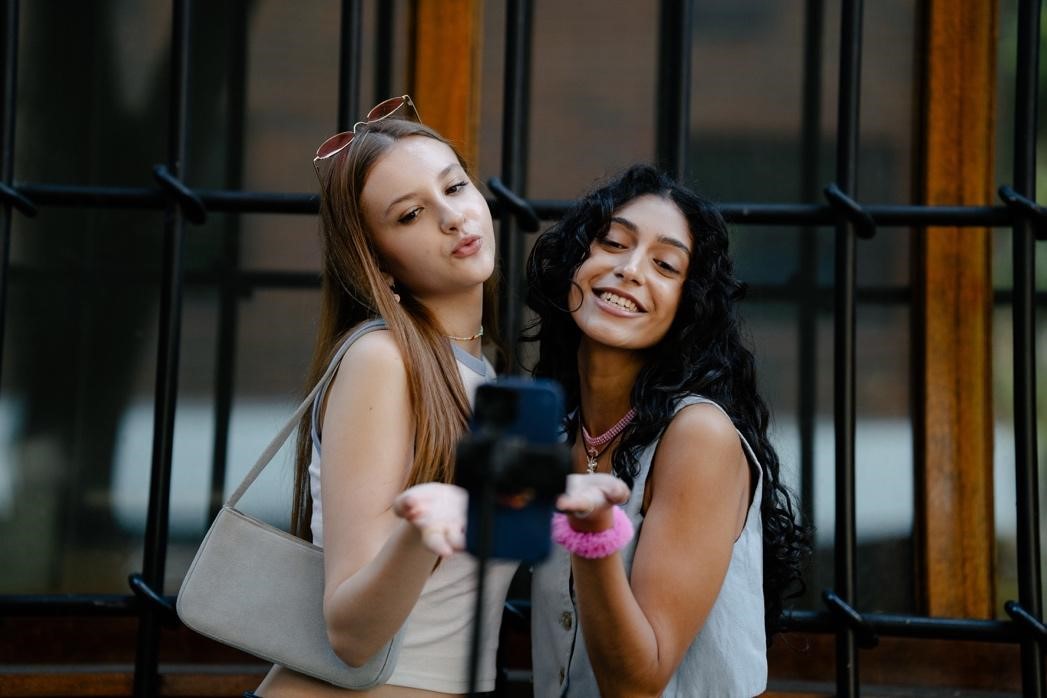
Audience and Demographics
One of the most prominent differences between TikTok and Instagram is their user bases. Instagram has a more diverse user base, with over two billion active monthly users, and appeals to a much broader audience. On the other hand, TikTok is a newer platform with 800 million active monthly users and rising. TikTok’s audience is mostly younger and comprises mainly Gen Z users. Hence if your target audience is younger, then TikTok might be the better choice for you. However, if you are looking to target a more diverse audience, then Instagram might be a better option.
In the case of Pakistan however, TikTok has emerged as the second most popular platform after Facebook with an approximate 30M user base and rising compared to Instagram which is somewhere closer to 16M users approximately, as of May 2023. While initially, TikTok emerged as a platform more favored in rural, semi-urban areas, with a tilt towards mass reach and popularity in the lower SECs, however with time it has gained momentum across social segments and is now as popular in the affluent urban sector. Instagram, on the other hand, has always been more celebrated in the upper SECs while gaining major traction with celebrities, lifestyle influencers and travel coaches, fashion, and self-care category creators.
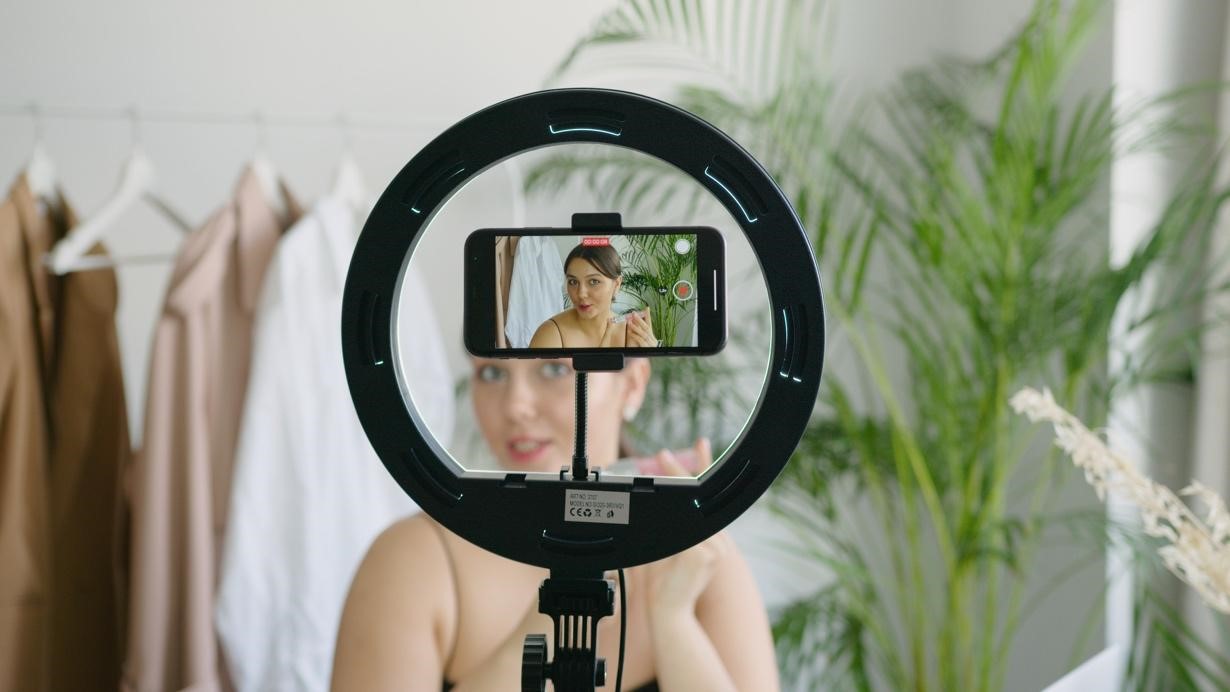
Content Creation
Another major difference between TikTok and Instagram is the type of content that is posted on the platform and what kind of content performs well on each. TikTok is solely a video-based platform that allows users to create vertical short-form videos with background music/audio and an array of filters. On the other hand, Instagram allows users to post images, carousels, stories, short-form videos (Reels), long-form videos (IGTV), streaming (Live), and listicles (Guides). Instagram’s algorithm also favors visually appealing ‘aesthetically pleasing’ content, making it a great platform for photographers, designers, and artists.

Engagement and Reach
Both TikTok and Instagram use unique algorithms that decide what content to show their users. Both platforms focus on analyzing user behavior and in turn generating specific content according to the preferences of the user. TikTok’s algorithm makes use of machine learning to generate a curated feed of videos based on user preferences and past interactions i.e., videos that users engage with more regularlyand on repeat; those that receive more likes, comments, and shares have a higher chance of appearing on the ‘For You’ page. Instagram’s algorithm also focuses on personalized content based on relevance and user interactions; however, it targets both static and video content while Tiktok prioritizes short-form videos and promotes content from a wider range of creators, hence making it easier to go ‘viral’ on TikTok.

Monetization
For influencers, monetization and how much revenue they are able to generate are critical factors to consider when choosing a platform. On Instagram, influencers can earn through sponsored posts, affiliate marketing, and selling their products. On the other hand, TikTok has its ‘Creator Fund’, where users can earn money based on the views and engagement their videos get. While both platforms offer monetization opportunities, Instagram has more lucrative options for influencers and has more established influencer marketing practices.
Hence, in conclusion, choosing between TikTok and Instagram can be a rather difficult decision for influencers. Both platforms offer unique features and benefits that can help influencers develop their careers and establish themselves in the content creator space. However, the decision ultimately depends on what your target audience is, what type of content you post, your engagement goals, and monetization objectives. We recommend experimenting with both platforms to find the one that works best for you!
Check out Walee’s Creator Academy to learn more tips and tricks on which platform works best for you. Keep creating!
How to Score your Dream Campaign?
What gets you excited when you think about how to secure your dream campaign? Is it the content, technology, futuristic approach, influencer or the brand you imagine yourself working with?
Let’s admit it, even content creators are all consumers and every consumer has their favorite brands in almost every category. On top of it, there are brands that make us excited just thinking about them. Chances are that if you love buying it, you most likely would love to talk about it. How about getting a chance to work with and promote the brand that makes you feel good? Tell the world why you feel that way.
Just imagining scoring your dream influencer marketing campaign feels so exciting. Think about how fulfilling it would be when you turn your imagination into reality. Want to learn how to make it possible? Keep reading to find out!
First, you will need to establish yourself in the influencer space. Create your own value as a content creator for any brand, including your favorite, to get noticed. Top brands often work with creators with a distinct following and above-average industry engagement rates. They should also possess a sizable reach among a specific niche audience, aiding their social media marketing and content creation efforts. But where and how do we get started on this journey of achieving our goal?

Target Audience & Brand Values
To succeed, create fantastic content ideas and execution formats, but it’s fruitful only if you have a loyal, resonating audience. The key that really helps is if the values of your content are the same as the brand you want to work with on a specific influencer marketing campaign. It doesn’t mean you need to change yourself or your content direction for the brand. However, your content must attract the same audience as the brand you want to tap into and make an impact.

Integration and Collaboration
These days brands have access to all the relevant information related to their influencer marketing campaigns. These include potential reach, audience insights, engagement rates, and relevant metrics about any influencer. Obtain these metrics through 3rd party tools like WALEE IM & WALEE IIR.
Smart, mature, and sophisticated brands have figured out that not selecting the right influencer can cost them a lot more than the content creators’ hiring price and worth. Hence, integrating your work around common topics, themes and clusters can help you achieve desired results quickly for brands to take notice.
For example, top beauty and fashion brands targeting women would likely select those content creators for their influencer marketing campaigns, whose content revolves around empowered women seeking beauty and fashion advice. However, if you are a blogger then the keywords need to depict the same if scanned through content audit. Besides this, collaborating with other creators with similar values will help you expand your reach and noticeability.

Required Skillset
If you want to get noticed in the commercial market then one must also possess the skill-set needed to be able to execute the desired format of content and make it stand out. This can either be in the form of capturing pictures, recording and editing videos or discovering unexplored places to eat or travel to. It doesn’t mean you need to become an expert at everything but at least have the basic command required to complete the task from ideation to presentation, whether you do it as a group of team members collaboratively or alone as a single social influencer, quality takes precedence over quantity.

Authentic Work
Another important factor is that large leading brands like to give more freedom to influencers after communicating the key idea behind the campaign. Influencers know their audience and a script which helps retain the authenticity of their content and minimize angles in promotion that would give away a contrived, artificial picture. A good example of such a pitch of ideas is the work of Mahvish Ahmed.

Power of Narrative
Another way to score your dream campaign is through the feeling that the influencer’s account is giving e.g. Arsalan Ash’s page exudes a local game geek feel, while Daniyal Sheikh has an investigative approach to his videos. Your tonal aesthetics and style should coincide with the brand’s intent. It might be through sensory branding, storytelling, empowerment or cause branding. Your account can give the same vibe as the brand and hence attract or persuade the brand to collaborate with the influencer for its content marketing.

Engage with Desired Brands
To get the attention of the brand(s) one wants to work with, it’s encouraged as a creator (from your official creator account) to engage with them on social media i.e. by liking and following their page activity, while sharing and commenting on their posts. This in turn will help to build a relationship with the brand and get you on their noticeability radar.
Reaching Out
Once you have established your niche and content that aligns with your dream brand, you can always reach out to them for collaboration. Just make sure to personalize your message and highlight your relevant experience and skills. Explain how you can help the brand achieve its marketing objectives, and provide examples of your previous work.

Be Patient
As building relationships with brands takes time, so don’t be discouraged if you don’t get an immediate response. Keep creating high-quality content and try not to miss any chances that can help you engage with the brand, as chances are that eventually, you’ll get noticed.
To summarize, the road to scoring your dream campaign with a desired brand can seem a little daunting for any creator. But if you have put in the hours to understand, study and know the brand, then the next step is working on your own strong persona as an influencer and infusing it to create high-quality content, while engaging and reaching out to target with your best foot forward. Last bit relates to consistency and most importantly being patient. Hence, with persistence and hard work, you can increase your chances of landing your dream campaign with your favorite brand. Let us know if you found these suggestions useful and feel free to share with us in the comments, if you would like to add any more to these.
Explore further tips and tricks on Walee’s Creator Academy to fuel your creativity! Do check it out and keep creating!
Create your own Niche as an Influencer
Becoming an influencer is an exciting opportunity to share your passions and interests with a wider audience. Create your own niche as an Influencer and standout in the creator space. In today’s digital age, influencer marketing has become an essential part of any successful marketing strategy. With the rise of social media platforms like TikTok, Instagram, and YouTube, social influencers and video creators have gained enormous followings and influence over their audience. Hence, in a crowded market, it can be challenging to stand out and gain a significant audience base.
One approach to establishing yourself as a successful content creator is to create your own niche. Creating your own niche allows you to distinguish yourself from other influencers in the content creator industry. It facilitates you to create your unique selling point and deliver value to your audience. Here are a few tips we would like to share with you on this topic.
Find your Passion
The first step in creating your own niche is to identify your passion. What are you truly interested in, and what could you talk about for hours on your influencer platform? It could be anything from cooking, to fashion, from travel to fitness, or even an amalgamation of multiple interests. Identifying your passion lets you be able to create content that is authentic, engaging, and that can resonate with your audience.
Research Your Audience
After recognizing your passion, it’s vital to explore your audience. Who are the people that would be interested in your content marketing? What are their needs and wants? By knowing your audience, you can create content that is relevant to them and provides value. You can also find out what type of content they like, the influencer platforms they use, and the ways in which they engage with other influencers in your niche. This helps you create content that echoes with them.

Define your unique selling point
To stand out as an influencer, you must define your unique selling point. What makes you stand out from other social influencers in your niche? This could be your personality, your approach to content, or the way you present yourself to your audience. Your unique selling point should be something that your audience can’t find anywhere else, and that should resonate with their aspirations, goals, and pain points.
Content-Type
Additionally, you can determine the type of content your audiences prefer, the platforms they frequent, and how they interact with other influencers in your niche. This information is vital for crafting social media marketing content creation that aligns with your audience’s interests. Creating high-quality content is essential once you have identified your niche and unique selling point. This could be in the form of blog posts, videos, social media posts, or any other type of content that your audience is interested in. Your content should be engaging, informative, visually appealing, and high quality.
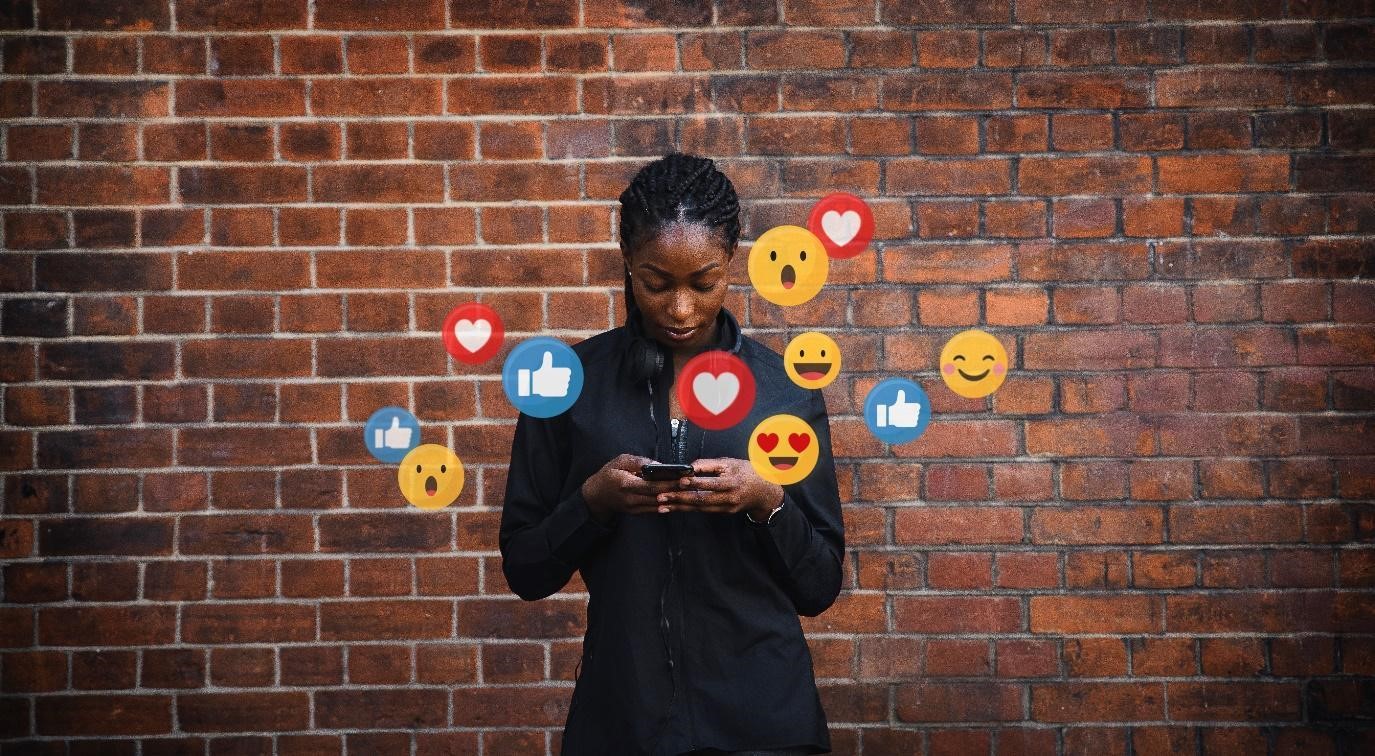
Engage With Your Audience
Lastly, engaging with your audience is crucial to growing your following and establishing yourself as an influencer. Respond to comments, ask for feedback, and show your followers that you care about them. This will help you build a loyal following and establish your presence as a content creator in your niche.
To summarise, creating your own niche as an influencer takes time and commitment. Identifying your audience is a crucial step in content marketing and social media marketing content creation. Understanding their needs and wants can help you create content that is valuable and resonates with them. If you are following the above-mentioned steps, then with continuity of effort you will have higher chances of establishing yourself as a successful content creator in a crowded market.
Additionally, it can aid in your influencer marketing efforts, allowing you to connect with social influencers and reach a broader audience through the right platform for influencers. Remember to stay consistent with your content and engage with your audience regularly to grow your following and achieve your goals.
Check out Walee’s Creator Academy to learn more tips and tricks. Keep creating!


